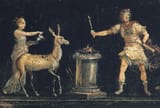Search Results
7/19/2025, 3:20:49 PM
>>40755948
obviously we no longer live is ancient mesopotamia to begin with and are very much removed from a lot of the practices that involved these deities. there is just so much material lost to the sands of time that it is difficult fashioning something actually coherent from all of this.
there is also the fact that there were particular social conditions that existed back when ishtar was worshipped which are no longer present now. there is no physical temple or physical gathering place for instance. we are all just shitposting on chatrooms and korean basketweaving forums. something else i am going by is also the article here:
https://acoup.blog/2019/11/01/collections-practical-polytheism-part-ii-practice/
a key concept they espouse is how much of the worship of the gods is grounded in a sort of pragmatism. offerings and rituals were done in order for rain or good harvest to come for instance. the development of ritual follows from what things appeared to have worked. it is this pragmatic backbone that a more serious spiritual practice can be gradually developed. it is not necessarily something that just gets developed overnight.
moving back to the subject of a sacred form of drawfagging there are a few influences i would like to bring into this. the first would be icons from orthodox and catholic christianity. what’s interesting about these is that they are not mere depictions but are also meant to be interfaces in which the divine is able to be revealed to us and we may have some sort of relation. icons have this tendency to provoke an austere reverence and deepened faith. honestly on /inana/, through the posting of ishtar-rin and other such depictions, there is already a movement hear towards icon-focused worship. this article further elaborates on this notion
http://opentranscripts.org/transcript/selfhood-and-the-icon/
obviously we no longer live is ancient mesopotamia to begin with and are very much removed from a lot of the practices that involved these deities. there is just so much material lost to the sands of time that it is difficult fashioning something actually coherent from all of this.
there is also the fact that there were particular social conditions that existed back when ishtar was worshipped which are no longer present now. there is no physical temple or physical gathering place for instance. we are all just shitposting on chatrooms and korean basketweaving forums. something else i am going by is also the article here:
https://acoup.blog/2019/11/01/collections-practical-polytheism-part-ii-practice/
a key concept they espouse is how much of the worship of the gods is grounded in a sort of pragmatism. offerings and rituals were done in order for rain or good harvest to come for instance. the development of ritual follows from what things appeared to have worked. it is this pragmatic backbone that a more serious spiritual practice can be gradually developed. it is not necessarily something that just gets developed overnight.
moving back to the subject of a sacred form of drawfagging there are a few influences i would like to bring into this. the first would be icons from orthodox and catholic christianity. what’s interesting about these is that they are not mere depictions but are also meant to be interfaces in which the divine is able to be revealed to us and we may have some sort of relation. icons have this tendency to provoke an austere reverence and deepened faith. honestly on /inana/, through the posting of ishtar-rin and other such depictions, there is already a movement hear towards icon-focused worship. this article further elaborates on this notion
http://opentranscripts.org/transcript/selfhood-and-the-icon/
Page 1
